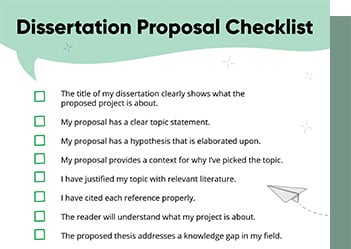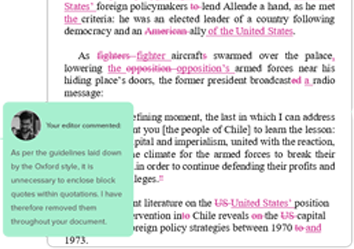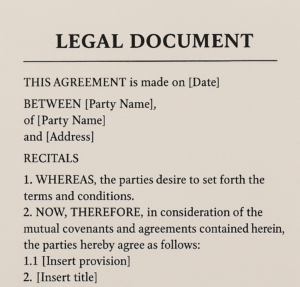Still have questions? Leave a comment

Checklist: Dissertation Proposal
Enter your email id to get the downloadable right in your inbox!
[contact-form-7 id="12425" title="Checklist: Dissertation Proposal"]
Examples: Edited Papers
Enter your email id to get the downloadable right in your inbox!
[contact-form-7 id="12426" title="Examples: Edited Papers"]Need
Editing and
Proofreading Services?

How to Write A Legal Document in 6 Easy Steps
 May 29, 2025
May 29, 2025 5
min read
5
min read
- Tags: Language, Writing Tips
Crafting a legal document requires attention to detail, clarity, and an understanding of legal principles. Hence, writing a legal paper can be challenging, especially for beginners. In this blog, you’ll learn 7 useful strategies for polishing your legal paper.
For beginners, we’ve explained how to write a legal paper from scratch in 6 simple steps. Before performing these 6 steps, it’s important to prepare for the writing process. Let’s understand this pre-writing process!
Ensure Your Legal Documents Are Error-Free! Get Started
How to prepare legal documents
An important step in preparing legal documents is to select a platform or software for writing legal documents. You can use Microsoft, Google Docs, or legal document writing software like Clio or Smokeball for this.
Some other steps for preparing the writing legal document are:
1. Define the document’s purpose and target audience
Before you write a single word, ask yourself: What is the purpose of the legal documents I’m drafting? Is it to inform, persuade, instruct, or record something?
Understand the goal you wish to achieve through the legal document. For example, is it a letter requesting information, a report summarizing findings, or a contract outlining an agreement? This will help you create a document outline.
2. Keep in mind the document’s target audience
Think about: Who will be reading this document? Their understanding of the subject matter will influence your writing style. For example, a document for experts will use a different language from one for the general public.
3. Choose an appropriate format and structure
The first step is identifying the type of legal document you need. Are you creating a contract, a will, a lease agreement, a power of attorney, a complaint, or something else? This will help you decide about the legal document structure.
Each document type has a specific purpose and a standard format. Using the wrong type will not help you achieve your goals.
4. Research relevant laws and requirements
Determine which laws and regulations apply to your document. This may involve federal, state, or local laws, depending on the subject matter.
Use online legal databases (like Westlaw or LexisNexis) to access statutes, case law, and regulations. These databases provide comprehensive legal information, helping in legal research and drafting.
5. Review existing documents
Analyze similar documents to see how they address relevant legal issues. This can provide valuable insights into standard clauses and formatting.
How to write a legal document
The first step for writing a legal document is to create a first draft. The following are important pointers to create the first draft:
1. Create a title and purpose statement
Give your document a clear and concise title that tells the reader what it’s about. For example, if the document is about renting a flat, the title “Rental Agreement” can be used. In contrast, if the document is for a project proposal, the title “Project Proposal” can be used. After the title, add a purpose statement that explains why you’re creating the document and what it aims to achieve.
Here is an example:
This document outlines the terms and conditions of employment between Vista Industries and Mr. Alfred Jones. It establishes the rights, responsibilities, and obligations of both parties during the course of employment.”
2. Divide the content into main and sub-sections
Organize your information into logical sections and subsections. This makes your document easier to read and understand. For example, you can create separate sections for obligations, rights, and conditions. Use headings and subheadings to break up the text and guide the reader.
3. Include important definitions and terms
If you use any specialized words or terms that might be unfamiliar to your reader, define them clearly. This ensures everyone understands what you mean. You can do this within the text itself or create a separate glossary of terms at the end.
4. Include signatures and dates
For legally binding documents, signatures show that everyone agrees to the terms. In contrast, dates show when the document was signed and when the agreement took effect. Make sure there’s enough space for signatures and dates. Also, indicate clearly who should sign where.
One of the most important components of a well-written legal document is legal clauses and provisions. Let’s explore this step!
5. Include all necessary legal clauses and provisions
If your document is a legal agreement (contract, lease, etc.), it needs specific clauses to make it legally binding. This includes information about the obligations and penalties wherever required.
The most accurate method is to directly quote the relevant clause or provision within your document. Enclose the quoted text in quotation marks and cite the source properly.
For longer clauses or provisions, it’s often clearer to present them as a separate paragraph or section, clearly labeled and cited.
Note: If a clause is short and easily integrated into your sentence, you can incorporate it directly without quotation marks. However, it’s important to still cite the source.
6. Edit and proofread
Check the document carefully for any spelling, punctuation, and grammar errors. Also, double-check all facts, figures, and dates for accuracy.
Plus, you need to ensure that the document is well-formatted and easy to read. This involves checking line spacing, margins, headers, footers, page numbers, etc.
Tips for effective legal writing
For clear legal writing, avoid double negatives or other complex negations. Instead, use clear, direct language. For example, instead of saying “not uncommon”, you can say “common”.
Some other tips for effective legal writing are:
1. Prioritize clarity over complexity
Avoid the use of overly technical language and jargon wherever possible. Use simple words and phrases that are easy to grasp. Remember, the goal is to make the document accessible to everyone. You can use online dictionaries like Nolo’s Plain-English Law Dictionary to ensure plain language legal writing.
2. Avoid ambiguity with specific wording
Make sure your wording is precise and specific to avoid any confusion or misinterpretation. Instead of using vague terms like “soon” or “reasonable,” use specific time frames or measurable criteria.
For example, say “within 30 days” or “not exceeding $500.” This helps prevent disputes or misunderstandings later on.
3. Use active voice for direct statements
Writing in the active voice means the subject of the sentence, who performs the action, is mentioned first. For example, instead of saying “The payment will be made by the client,” say “The client will make the payment.” This helps identify who is responsible for each action.
4. Remove unnecessary words
Cut out any words that don’t add meaning or clarity. Every word should serve a purpose. Avoid phrases like “due to the fact that” (use “because” instead), “in the event that” (use “if” instead), or “at this point in time” (use “now” instead).
5. Give character names wherever relevant
When referring to people in your document, use their names or specific titles instead of generic terms like “he,” “she,” or “they.” This helps make the document more precise and avoids confusion, especially if you’re referring to multiple people.
6. Pay attention to the tone
Decide the tone depending on the type of legal document. Maintaining a professional, impartial tone is crucial for documents like contracts, legal notices, and court filings. These documents should be free of emotional language, slang, or jokes, as they are meant to convey information clearly and objectively.
However, some legal documents, such as client communications, legal blog posts, or educational materials, might not require neutrality. They can benefit from a more engaging or persuasive tone.
7. Maintain simplicity and consistency
Following these key principles of legal writing is crucial for creating professional legal documents. A good practice is to start with the most important information and then provide supporting details. You can also use numbered or bulleted lists to break down complex information into simple points.
Another good practice is to be consistent in the use of legal terms. Avoid using multiple terms for the same idea, as this can cause confusion. Instead, choose specific terms for key concepts and use them consistently throughout the document.
Also, if you must use acronyms or abbreviations, define them the first time they appear and use them consistently thereafter.
You can refer to this step-by-step guide to writing a legal document while creating a first draft. However, it’s important to have the text edited and proofread by experts to eliminate any language errors.
At PaperTrue, we can help you achieve this goal. We provide expert legal editing and proofreading services to elevate your legal document.
Explore our website and get in touch to learn more about our services!
Here are some useful resources for you:







